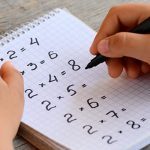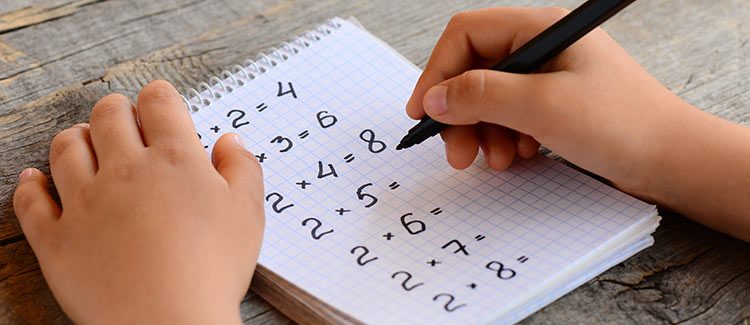Everyday life offers lots of opportunities for learning and practicing important math lessons, especially when you bring a sense of fun and adventure.
-
Making multiplication meaningful
Part of math this year is not just learning multiplication tables, but mastering them. Here’s a fun way to help: pick a number that divides by lots of numbers such as 24. Ask your child what pairs of numbers can be multiplied to equal 24 (3 x 8, 6 x 4, 2 x 12, and 1 x 24). Use beans or chocolate chips to put them in columns and rows (ex: 3 rows of 8 pennies). Use this worksheet to practice more multiplication.
-
Fractions at the table
During meals, ask your child to cut something (e.g., a waffle) into two, three, or four equal pieces. It’ll help them understand that fractions are equal parts of a whole. Then try the same thing with two objects: if 4 people want to share 2 oranges equally, how much does each person get? What if you have 3 oranges? The idea is for your child to get the connection between division and fractions. Here’s what this looks like with real 3rd graders.
-
Put the athlete back in mathlete
If your child is into sports, help your child find a website that covers your child’s favorite sport. Then do the math, focusing on the four operations. For example: how many more points did this team score than that team? For now, steer clear of anything involving averages or decimals — save that for 5th grade. Get 13 more 3rd grade math tips!
-
Fitbit your child’s reading
If reading is your child’s favorite thing, help show off the great number of words they’re consuming by tracking their progress. Make a table that shows how many pages she reads each day. Analyze the data together. Which day do you read the most? About how many pages will you read in the next week? Get 13 more 3rd grade math tips!
-
Drill but don’t kill
If you practice times tables with your child, you can make it really fun. Focus on 1– 10, but feel free to go a little higher if your child can handle it. When your child has trouble solving one, help your child “reason” it out. For example, if 4 times 6 is hard, think about 4 times 5 — what is that? Would 4 times 6 be more or less? Why? Give your child some practice with this worksheet.
-
Putting the green into grocery
Getting kids curious about the cost of little purchases at the store can go a long way toward helping them nail third grade math. Next time you’re shopping, ask your child how much it’ll cost to buy six boxes of cereal if each one costs $3. Or ask how many loaves of bread you can buy with $16 if each loaf costs $4. You can give your child practice with this dollar sense worksheet, too.
-
Measure for measure
Learning how to calculate the area of a two-dimensional shape is a key third grade skill. How to help? Get out the measuring tape and ask your child to figure out which of the following household items has the biggest area: the TV screen, a table, the bathroom floor, and their bed. Get 13 more 3rd grade math tips!
-
Problem solving
A huge amount of higher math is just problem solving, pure and simple. How to help with this crucial life skill? When your child encounters a problem — in homework or in real life — resist the urge to jump in and solve it. Instead, ask What do you think you should try first? Working through challenges independently will help boost your child’s problem-solving skills. See all 3rd grade math tips.
-
Measuring skills
Measuring things and making numbers easy to compare and analyze is a skill your third grader started to learn this year (and will use more in the future). Give your child some real-life practice. Hand your child a tape measure and have them figure out the height of everyone in the family — down to the quarter-inch. Then, have your child plot the numbers on a number line. Can someone else read their chart and figure out who’s the tallest and by how much? See all 3rd grade math tips.
-
Fraction action
You don’t want your third grader to forget what they’ve learned in school this year — especially fractions. Studies show that kids lose knowledge over the summer (it’s called summer learning loss) and it’s worse for math than for reading. To stave off learning loss, have your child draw 8 shapes (practicing their geometry skills), including one circle and various regular polygons. Now have them split these shapes into equal-sized fractions. Randomly call something out — color ⅔ of shape 1, ⅞ of shape 2, ¼ of shape 3, etc. How’d they do? To keep your child’s math skills fresh, check out all of our DIY 3rd grade math tips.






